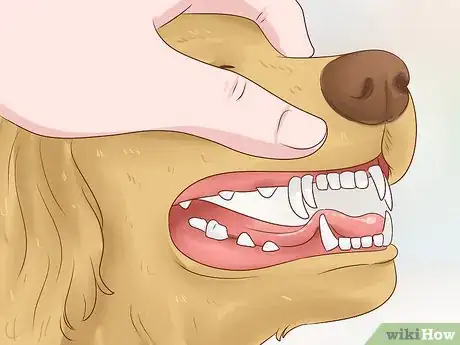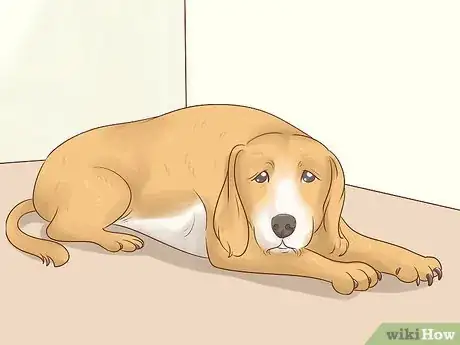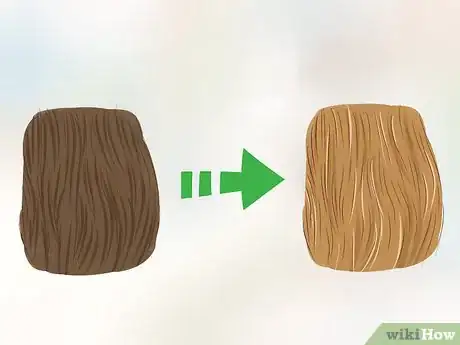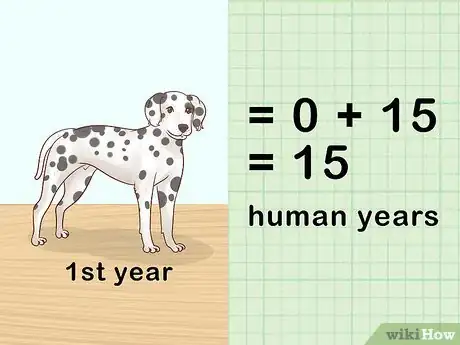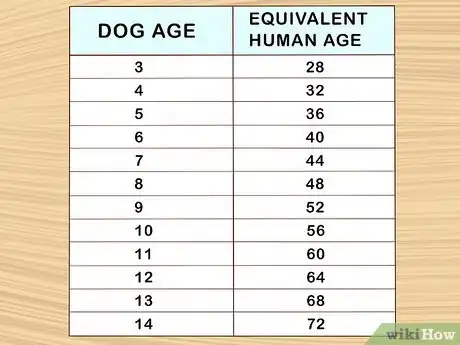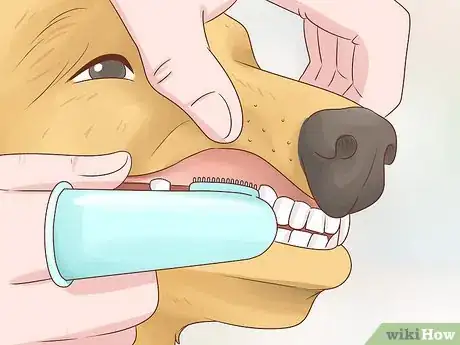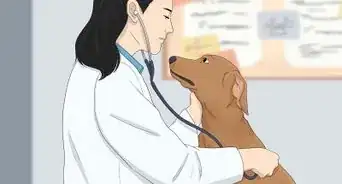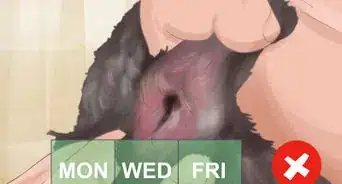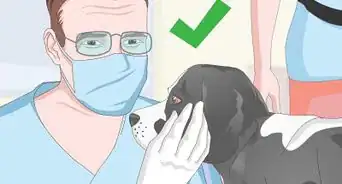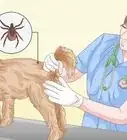This article was co-authored by Lauren Baker, DVM, PhD. Dr. Lauren Baker is a Veterinarian and Assistant Scientist at the University of Wisconsin-Madison. With over 10 years in veterinary medicine, she specializes in the concept of “one health,” which uses insights from veterinary medicine to help human medical research. She holds a Ph.D. in Comparative Biomedical Sciences, a Doctor of Veterinary Medicine, an MS in Comparative Biomedical Sciences, and a Bachelor’s degree in Psychology from the University of Wisconsin-Madison.
This article has been viewed 101,872 times.
If you want to determine your dog's age, look at signs like teeth, eyes, and fur color. If you want to know how old your dog is in human years, take your dog's actual age as well as its size into account. If you're unsure of your dog's age, take it to a veterinarian for evaluation.
Steps
Determining Your Dog's Actual Age
-
1Look to teeth to determine a puppy's age. If you have a puppy, it's fairly easy to determine its age by examining its teeth. Teeth start developing during a puppy's first year. The stage of teeth development is tied to a puppy's approximate age.
- At one month old, teeth will have just started pushing through the gums.
- At two months, a puppy will have a full set of deciduous (baby) teeth near the front of the mouth.
- At four months, adult canines and incisors will start to come in.
- By seven months, a puppy will have a full set of adult teeth and will have developed molars in the back of the mouth.
- When a puppy reaches a year old, you should notice ridges or bumps on both the lower and upper top front teeth.
- Keep in mind that teeth tend to erupt later in toy dog breeds.
-
2Note changes in teeth for an older dog. As a dog ages, their teeth change. Changes in teeth can help you assess a dog's approximate age.
- Ridges on the incisors change as a dog ages. By the time the dog is three years old, the ridges will have worn off the bottom incisors. By five years old, the ridges will have worn off the upper incisors as well.[1] A small amount of ridges on the upper front four teeth indicate your dog is between three and four.
- By seven, a dog's teeth are completely smooth.
Advertisement -
3Look for signs of aging. Older dogs tend to be less energetic than younger dogs. Senior dogs often have small benign lumps on the body. They will also be less interested in playing than younger dogs. They are generally less muscular than younger dogs.
-
4Examine your dog's eyes. Cloudy eyes are a sign of natural hardening of the lens as the dog ages, and this is called lenticular sclerosis. If your dog shows other signs of aging, such as smooth teeth and low energy, lenticular sclerosis can help you confirm your dog is older than seven. Lenticular sclerosis and cataracts are not the same thing. Cataracts are white and opaque and they are also common in senior dogs. However, some dogs develop cataracts young due to genetic reasons.[2]
- Cataracts will affect your dog's vision, whereas lenticular sclerosis will not.
-
5Use fur color to determine age. Fur color often changes as a dog ages. However, fur color is not the best means of determining age. However, when taken into account with other factors like teeth, fur may help determine a dog's age. Most dogs have some graying fur past the age of five. Graying hair is typically found around the muzzle.[3]
- Some dogs gray as early as two, depending on their environment and genetic makeup. Fur color can help confirm a dog is older when taken into consideration alongside other factors, like teeth and activity level. It should not be used as the sole means to determine a dog's age.
-
6Take your dog's size and breed into account. Larger breeds tend to have shorter lifespans. They may show signs of aging younger than smaller dogs. Great Danes, for example, typically live around seven years while Chihuahuas often live well into their teens. A bigger dog may show signs of aging early. In general, you can assume a big dog showing significant signs of aging is around seven or eight while a small dog can be assumed to be ages 10 or up.[4]
Determining Your Dog's Age in Human Years
-
1Add 15 years for the first year. While conventional wisdom says you should multiply a dog's age by 7 to determine human years, dogs are well over 7-years-old by their first year. Most breeds of dogs are about 15-years-old in human years by the time they are one years old.[5]
-
2Add nine years for the second year. By the time they are two, you can add nine additional years to your dog's age. Regardless of breed and size, most dogs are approximately 24 by the time they're two.[6]
-
3Add five years for each subsequent year. As a general rule of thumb, you can add about five years to a dog's age for every subsequent year. By three, most dogs will be 28 in human years. By four, most dogs will be 32 in human years, and so on.[7]
-
4Keep in mind larger breeds age faster. Bigger breeds tend to age faster than normal breeds. While no one understand the precise reason for this, big dogs tend to have shorter lifespans. By around six, big to medium size breeds will age faster than smaller breeds. There is no precise gauge for determining a dog's human years, but most big breeds will be a few years older than small breeds.[8]
- A Great Dane, for example, may start aging 10 to 12 years in human years after six as opposed to a smaller breed.[9] At 8, a large breed like a Great Dane may be a considerably older than a smaller breed at 8.
Seeking Help from a Vet
-
1Have your vet examine your dog. If you're unsure of your dog's age, have your vet conduct an examination. Your vet can check things like teeth, hair, and eyes to get a rough sense of your dog's age. A vet will be more qualified to determine age based on physical factors than you.
-
2Get a blood panel done. If you're really unsure of your dog's age, a blood panel may provide some insight. A vet can take a blood panel to determine the functions of organs like the kidneys and liver. A dog's organs will function differently at different ages.[10]
- However, while this can give you a rough sense of your dog's age, your vet may only be able to determine an approximate age range. The only way to know your dog's age for sure is to know their birthday.
- If you don't know much about your dog's history, then you might want to take them to see a veterinarian and have bloodwork done anyway. A blood panel is a good, general indicator of your dog's health and it can also identify problems before they become serious illnesses.
-
3Talk about keeping your dog young. If your dog is older or middle aged, talk to your vet about ways to keep your dog healthy. The risk for age-related diseases rises as a dog gets older, so make sure you provide your dog the healthiest lifestyle possible as it ages.[11]
- Your vet may want you to begin brushing your dog's teeth, as teeth decay with age. Your vet can provide you with a toothbrush and toothpaste for your dog.
- Keep your dog active to control its weight. Daily walks are a great way to control your dog's age.
References
- ↑ http://www.merckvetmanual.com/digestive-system/dental-development/estimation-of-age-by-examination-of-the-teeth#v4731506
- ↑ https://vcahospitals.com/know-your-pet/lenticular-sclerosis-in-dogs
- ↑ http://www.pawculture.com/tips-advice/pet-parenting-how-tos/decoding-your-dogs-age-what-to-look-for/
- ↑ http://www.dogster.com/lifestyle/how-can-you-tell-how-old-a-dog-puppy-is-age-determine-ask-vet
- ↑ http://www.akc.org/content/entertainment/articles/how-to-calculate-dog-years-to-human-years/
- ↑ http://www.akc.org/content/entertainment/articles/how-to-calculate-dog-years-to-human-years/
- ↑ http://www.akc.org/content/entertainment/articles/how-to-calculate-dog-years-to-human-years/
- ↑ http://www.akc.org/content/entertainment/articles/how-to-calculate-dog-years-to-human-years/
- ↑ http://www.dogster.com/lifestyle/how-can-you-tell-how-old-a-dog-puppy-is-age-determine-ask-vet
About This Article
To determine your puppy's age, check to see if its teeth are just pushing through the gums, which happens at around 1 month. If your puppy has a full set of baby teeth, it's probably around 2 months old. If you see adult canines and incisors starting to come in, your dog is 4 months old. However, if your puppy has a full set of adult teeth, it's probably closer to 7 months old. For older dogs, look for changes like worn ridges off their bottom incisors, which happens by the time they’re 3, or off their upper incisors, which happens by the time they’re 5. To learn from our Veterinary reviewer how to determine your dog's age from its eyes and fur, read on!

